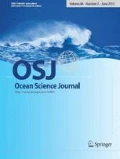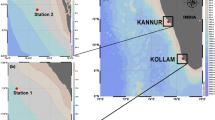Abstract
Response of surface subtidal current to wind and outflow plume in the bay-shape estuary, which had been artificially made by the Samangeum reclamation dike with two sluices in the west coast of Korea, was examined using the ocean radar-derived current data obtained in the summer 2010. The southerly wind was dominant due to Asian summer monsoon and the outflow plume water was discharged by the gate operation of the Shinsi and Garyeok sluices separated by 11 km into the study area that are opened in a southwestward direction. The monthly-mean flow pattern consisted of the westward outflow currents around the two sluices, the along-dike currents between the two sluices and the northward currents in the outer bay. Based upon the complex correlations of subtidal current to wind and outflow jets we explained that the northward mean current in the outer bay be formed by both the southerly wind-driven current and the geostrophic current by mean pressure setup due to the Ekman transport and plume water accumulation in the inner bay, and the along-dike mean current may be induced by the southerly wind that generates on-dike currents in the central region of study area and leads to pressure setup toward the dike between the two sluices. Combination of outflow jets, wind and coastline configuration affects variations of subtidal surface current in the inner bay. Variability of subtidal current in the outer bay is dominated by wind variation. The southerly wind produced the northward current in the outer bay though the outflow plumes from the two sluices turned clockwise from the inner to the outer bay due to the geostrophic balance when the wind was calm. The wind factor was from 2% to 7% depending on the amount of freshwater outflow and wind speed. Occasionally, when plume water discharges were large and the southerly wind was stronger than 5 m/s, a large eddy with a closed loop current was produced off the Shinsi sluice.
Similar content being viewed by others
References
Allen JS (1973) Upwelling and coastal jets in a continuously stratified ocean. J Phys Oceanogr 3:245–257
Awaji TN, Imasato N, Kunishi H (1980) Tidal exchange through a strait: a numerical experiment using a simple model basin. J Phys Oceanogr 10:1499–1508
Barrick DE, Evans MW, Weber BL (1977) Ocean surface currents mapped by radar. Science 198:138–144
Beardsley RC, Limeburner R, Kim K, Candela J (1992) Lagrangian flow observations in the East China, Yellow and Japan Seas. La Mer 30:297–314
Bowden KF (1983) Physical Oceanography of Coastal Waters. Ellis-Horwood, New York, 302 p
Chapman RD, Shay LK, Graber HC, Edson JB, Karachintsev A, Trump CL, Ross DB (1997) On the accuracy of ocean radar surface current measurements: Inter-comparisons with shipbased sensors. J Geophys Res 102(C8):18737–18748
Choi BH (1980) A tidal model of the Yellow Sea and the Eastern China Sea. KORDI, Ansan, KORDI Report 80-02, 72 p
Choi BH (2001) Effect of Saemangeum tidal barriers on the Yellow Sea tidal regime. In: Proceedings of the first Asian and Pacific Coastal Engineering Conference, APACE 2001, Dalian, China, pp 25–36
Choi B-J, Wilkin JL (2007) The effect of wind on the dispersal of the Hudson River plume. J Phys Oceanogr 37. doi:10.1175/JPO3081.1
Choi HY, Lee SH, Yoo KY (1999) Salinity distribution in the mideastern Yellow Sea during the high discharge from the Keum River weir. J Korean Soc Oceanogr (The Sea) 4:1–9 (In Korean)
Choi BH, Kim KO, Lee HS, Yuk JH (2010) Perturbation of regional ocean tides due to coastal dikes. Cont Shelf Res 30:553–563
Ekman WW (1905) On the influence of the Earth’s rotation on ocean currents. Ark Mar Astr Fys 2:1–53
Fernandez DM, Vesecky JF, Teague CC (1996) Measurements of upper ocean surface current shear with high frequency radar. J Geophys Res 101(C12):28615–28625
Fong DA, Geyer WR (2001) Response of a river plume during an upwelling favorable wind event. J Geophys Res 106:1067–1084
Fong DA, Geyer WR, Signell RP (1997) The wind-forced response on a buoyant coastal current: Observations of the western Gulf of Maine plume. J Marine Syst 12:69–81
Graber HC, Haus BK, Chapman RD, Shay LK (1997) HF radar comparisons with moored estimates of current speed and direction: Expected differences and implications. J Geophys Res 102:18749–18766
Heaps NS (1972) Estimation of density currents in the Liverpool Bay area of the Irish Sea. J Roy Astron Soc 30:415–432
Hwang J-A, Lee S-H, Choi B-J, Kim C-S (2010) Application of objective mapping to surface currents observed by HF radar off the Keum River estuary. J Korean Soc Oceanogr (The Sea) 15(1):42–55 (In Korean)
Imasato N (1983) What is tide-induced residual current? J Phys Oceanogr 13:1307–1317
Kang SK (2002) Study on tidal change prediction due to the large scale of coastal reclamation (TIDPRE, II). KORDI Report BSPM 191-00-1560-2, 426 p
Kim CS, Lee SH, Son YT, Kwon HK, Lee KW, Kim YB, Jeong OU (2006) Changes of surface M2 currents as observed HF radar before and after Saemangeum fourth tidal dike closing. J Korean Soc Oceanogr (The Sea) 11(2):37–48 (In Korean)
Kim CS, Lee SH, Son YT, Kwon HK, Lee KW, Choi BJ (2008) Variations in subtidal surface currents observed with HF radar in the coastal waters off the Saemangeum area. J Korean Soc Oceanogr (The Sea) 13(1):56–66 (In Korean)
Kim K, Rho HG, Lee S-H (1991) Water masses and circulation around Cheju-Do in summer. J Oceanol Soc Korea 26:262–277 (In Korean)
Kim SY, Terrill EJ, Cornuelle BD (2007) Objectively mapping HF radar-derived surface current data using measured and idealized data covariance matrices. J Geophys Res 112:C06021. doi:10.1029/2006JC003756
Kim SY, Cornuelle BD, Terrill EJ (2009) Anisotropic response of surface currents to the wind in a coastal region. J Phys Oceanogr 39:1512–1533. doi:10.1175/2009JPO4013.1
Kundu PK (1976) Ekman veering observed near the ocean bottom. J Phys Oceanogr 6:238–242
Kwon KM, Choi B-J, Lee S-H, Cho Y-K, Jang CJ (2011) Coastal current along the eastern boundary of the Yellow Sea in summer: Numerical simulations. J Korean Soc Oceanogr (The Sea) 16(4):155–168 (In Korean)
Lee S-H, Beardsley RC (1999) Influence of stratification on residual tidal currents in the Yellow Sea. J Geophys Res 104: 15679–15701
Lee S-H, Choi HY, Son YT, Kwon HK, Kim YK, Yang JS (2003) Low-salinity water and circulation in summer around the Saemangeum area in the west coast of Korea. J Korean Soc Oceanogr (The Sea) 8(2):138–150 (In Korean)
Lee S-H, Moon HB, Baek HY, Kim CS, Son YT, Kwon HK, Choi B-J (2008) On the accuracy of current measurement by HF radar in the coastal sea off the Keum River estuary. J Korean Soc Oceanogr (The Sea) 13(1):42–55 (In Korean)
Lee S, Lie HJ, Song KM, Cho CH, Lim EP (2008) Tidal modification and its effect on sluice-gate outflow after completion of the Saemangeum Dike, South Korea. J Oceanogr 64:763–776
Lie HJ, Cho CH, Lee S, Kim ES, Koo BJ, Noh JH (2008) Changes in marine environment by a large coastal development of Seamangeum reclamation project in Korea. Ocean and Polar Res 30:475–484
Lie H-J (1986) Summertime hydrographic features in the southeastern Hwanghae. Prog Oceanog 17:229–242
Lie H-J, Cho CH, Lee JH, Lee S, Tang Y (2000) Seasonal variation of the Cheju Warm Current in the northern East China Sea. J Oceanogr 56:197–211
Lipa BJ, Barrick DE (1983) Least-squares methods for the extraction of surface currents from CODAR cross-loop data: Application at ASLOE. IEEE J Oceanic Eng 8:226–253
Liu Y, MacCready P, Hickey BM (2009) Columbia River plume patterns in summer 2004 as revealed by hindcast coastal ocean circulation model. Geophys Res Lett 36:L02601. doi:10.1029/2008GL036447
McWillams JC, Huckle E, Shchepentkin AF (2009) Buoyancy effects in a stratified Ekman layer. J Phys Oceanogr 39:2581–2599
Prandle D (1982) The vertical structure of tidal currents and other oscillatory flows. Cont Shelf Res 1(2):191–207
Shin EJ, Lee S-H, Choi HY (2002) Numerical Model Study for Structure and Distribution of the Keum River Plume. J Korean Soc Oceanogr (The Sea) 7:157–170 (In Korean)
Simpson JH (1997) Physical processes in the ROFI regime. J Marine Syst 12:3–16
Son YT, Lee S-H, Kim CS, Lee JC and Lee GH (2007) Surface current variability in the Keum River Estuary (South Korea) during summer 2002 as observed by high-frequency radar and coastal monitoring buoy. Cont Shelf Res 27:43–63
Suh SW, Cho WH, Yoo GS (2006) Simulation of mixing transport on inner reservoir and influence impacts on outer region for the Saemangeum effluents caused by gate operation. J Korean Soc Coast Ocean Eng 18:43–52 (In Korean)
Thompson RORY (1983) Low-pass filters to suppress inertial and tidal frequencies. J Phys Oceanogr 13(6):1077–1083
Uda M (1934) The results of simultaneous oceanographical investigations in the Japan Sea and its adjacent waters in May and June, 1932. J Imp Fish Exp Station 5:57–190
Whitney MM, Garvine RW (2005) Wind influence on a coastal buoyant outflow. J Geophys Res 110:C03014. doi:10.1029/2003JC002261
Yelland MJ, Taylor PK (1996) Wind Stress Measurements from the Open Ocean. J Phys Oceanogr 26:541–558
Yoshikawa Y, Matsuno T, Marubayashi K, Fukudome K (2007) A surface velocity spiral observed with ADCP and HF radar in the Tsushima Strait. J Geophys Res 112: C06022. doi:10.1029/2006JC00362
Zhao J, Chen X, Hu W, Chen J, Guo M (2011) Dynamics of surface currents over Quingdao coastal waters in August 2008. J Geophys Res 116. doi:10.1029/2011JC006954
Author information
Authors and Affiliations
Corresponding author
Rights and permissions
About this article
Cite this article
Lee, SH., Kang, CY., Choi, BJ. et al. Surface current response to wind and plumes in a bay-shape estuary of the eastern Yellow Sea: Ocean radar observation. Ocean Sci. J. 48, 117–139 (2013). https://doi.org/10.1007/s12601-013-0010-5
Received:
Revised:
Accepted:
Published:
Issue Date:
DOI: https://doi.org/10.1007/s12601-013-0010-5




